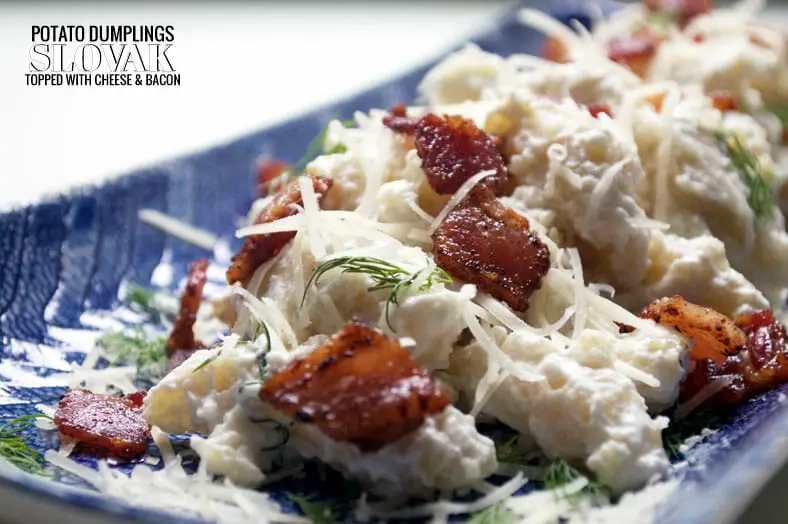Potatoes are the heart of Eastern European culinary tradition, featured prominently in many dishes, and halusky – the national dish of Slovakia – epitomizes the fondness for this tasty tuber.
In what is now becoming a familiar tale here on Arousing Appetites, what’s now an ingredient central to a country’s cuisine was a foreign introduction from a distant land not too long ago. In this case, potatoes, although they are now a pan-European mainstay, are originally an import from the New World.
But unlike many other fruits and vegetables that traveled their way into European bellies, potatoes had a rocky landing on the continent. Where some saw a vegetable with endless possibilities, some saw an evil vegetable with ties to witchcraft.

HALUSKY: TUBERS FROM THE INCAS TO THE IBERIANS, FEAR OF MALEVOLENT SPUDS, AND A CELEBRATION OF POTATO DUMPLINGS
High in the Andes mountains, where the air is thin and cold, a mighty empire once stood. The Incan Empire lasted for one hundred years and stretched along the Pacific Ocean from modern day Colombia to Argentina.
In addition to their architecture, the Inca people were masters of agriculture, and one of their most important crops was the potato. It grew well in the high altitudes of the Andes, and it provided the Inca with the nutrition necessary to survive in a challenging climate.
POTATOES AND THE ANDES
Like many of the fruits and vegetables that we enjoy today, potato cultivation began thousands of years ago. Early evidence suggests they may have grown in the wild along the Chilean coast as long ago as thirteen thousand years, though it was roughly ten thousand years ago that they were domesticated. It’s from then on that they played a crucial role in the diet of the Andean people.
If you’re looking for the cold hard facts about potato cultivation, though, the oldest archeologically verified tuber remains date back to 2,500 BCE. Although they do seem to hold up pretty well in our pantry, evidently potatoes can’t last for longer than 5,000 years! These ancient potatoes were found in Peru, which is no coincidence since the capital of the Incan empire was the city of Cuzco in modern day Peru.
The Andes are the highest mountain range outside of Asia and offer a harsh climate to its inhabitants. To build an empire like the Incans did, food security was paramount, and potatoes provided just that. Without potatoes, humans might not have been able to survive (let alone thrive) in the Andes like they did.
The Andean potatoes are frost hardy, meaning they can be grown at high elevations where freezing temperatures are a regular occurrence. The Incas also used a brilliant method to preserve potatoes, using the freezing Andes nights to their advantage to make a substance called chuño.
Chuño was made by allowing potatoes to sit out at night and freeze. In the daytime they were stomped on to squeeze the water out, then allowed to freeze again overnight. The freeze dried potatoes were then stored underground, in frozen storage areas. This chuño provided a stable food source for the Inca, freeing them up to focus on creation of a 14,000 mile road system in the Andes mountains.
That’s right, 14,000 miles of mountain road, built in the 1400s. Oh, and they still exist today!
You May Also Like…
If you like dumplings, you might want to check out our other recipe for Tibetan Steamed Dumplings (Momos) with sauce, or Mongolian Meat Dumplings (Buuz), or Siberian Meat Dumpling (Pelmeni)
CONQUISTADORS BRING POTATOES TO SPAIN AND SCARE EUROPEANS
When Spanish conquistadors arrived at the Andes in the 1500s, they brought with them disease, and sadly, the end of the impressive Inca empire.
In general, you could say that what they brought back to Europe was a little more… constructive. Of the many things that they took back, potatoes were one of the most influential. However, they were originally taken aboard Spanish ships as an afterthought, not because the Spaniards saw the high-yield, nutritional and robust value of this dense tuber.
There’s so much to say about the arrival of potatoes in Europe, but put simply, they transformed Europe. For the same reasons that potatoes were so important to the Inca, they became crucial to the Europeans. Since potatoes are highly nutritions and high yielding, it was not long after they reached Europe that the European population boomed. This boom in turn gave rise to modern day industrial agriculture.
But we should mention that this almost wasn’t the case. When potatoes were first traveling out of Spain and across Europe, peasants feared them.
If you had never seen a tuber before, you can imagine it would be scary to see something lumpy like potato bush pulled out of the ground and a bunch of gnarled, dirty looking rocks hanging with it. You probably wouldn’t think “mmm, let’s whip that up with some milk and butter!”
That’s also not to mention that potatoes are in the nightshade family. Nightshades are flowering plants, and many of them are toxic to humans. European peasants recognized the flowers of the potato plants for their “nightshadedness” and decided that potatoes too must be poisonous, and even evil. It’s ironic, though, that they ate many other nightshades without hesitation at the same time. Hypocrisy be thy name!
Fortunately, the fear and mistrust of the spuds didn’t last forever, and they gradually made their way into gardens and farms, onto dinner plates, and into European hearts and tummies.
THE POTATO DUMPLING FESTIVAL
Areas of Europe that really took to potatoes were Central and Eastern Europe. Potatoes are nowadays featured heavily in most Central and Eastern European cuisine. The Czechs enjoy a garlic soup that calls for plenty of potatoes, and the Belarusians make a delicious sausage stuffed potato pancake.
In Slovakia, a most popular homage for potatoes takes the form of halusky. The most traditional version of the dish is called bryndzové halušky, which calls for a common sheep’s milk cheese bryndza to adorn the dumplings with flavor.
As the Slovak national dish, it comes as no surprise that there is an annual halusky festival celebrating all things halusky. The festival, hosted in a tiny village called Turecká, has been held since the 1990s. Each year, there is even a halušky eating competition! With all due respect to Nathan’s hot dog eating contest, we have to give it up for the Slovaks who can power through these potato dumplings. They’re delicious, but boy are they filling.
We may not be in for next year’s contest in Turecká, but we sure are glad that potatoes made their way to Slovakia from the Andes mountains.
ABOUT THE RECIPE
As far as preparing halusky, it’s a really easy recipe to prepare, and it takes little to no time at all. In fact, the most important part of the process isn’t in cooking but in grating.
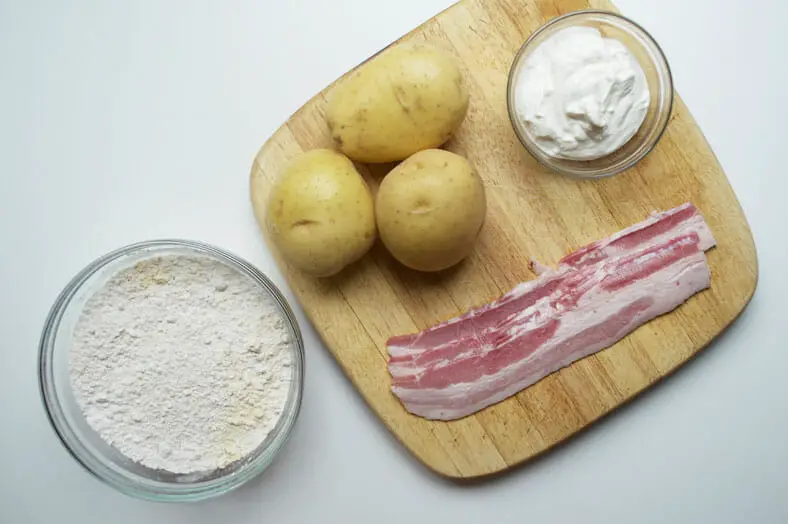
Preparing a good dough for halusky matters the most. Considering the batter is no more than a mixture of potato and flour, you might find this perplexing like we did, but there are “pro tips” we can share that will maximize your success.
You’ll start by grating washed and peeled potatoes into a bowl. Keep in mind that the smaller the grate, the better your halusky become! Larger grates ups its chances of falling apart when the dumpling’s boiled, so do try to grate the potato as finely as you can.
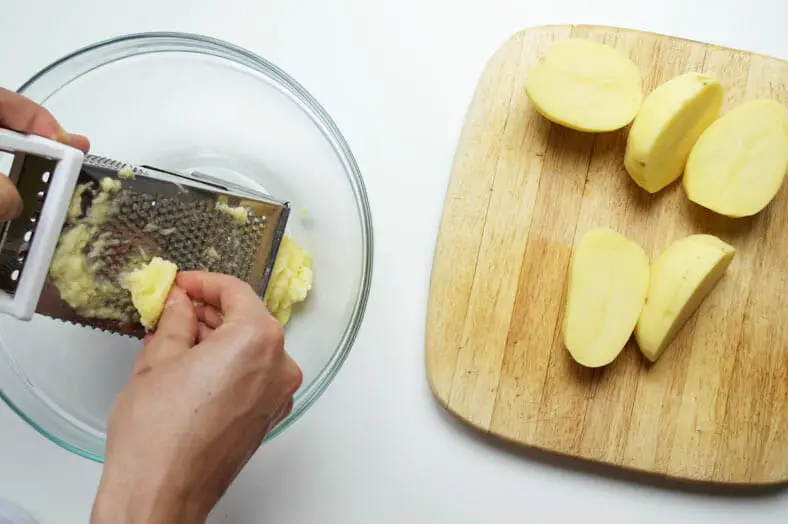
Just like with latkes, don’t make the mistake of moving onto the next step without removing excess moisture from your potato! Press your freshly grated potatoes into a mesh colander and extract out as much of the excess water you can. Do capture this liquid, though, since there’s excess starch that sinks to the bottom and can be re-added to your halusky dough as a dynamite thickening agent.

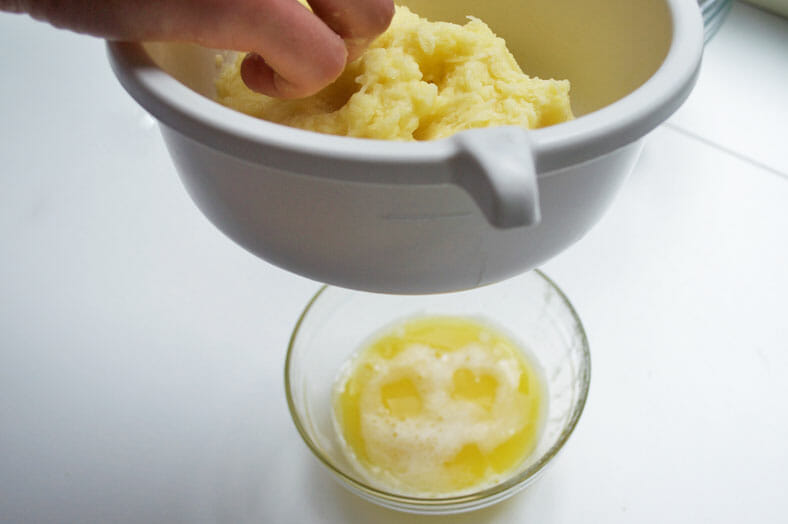
When you’re sure the potatoes have ceded their very last drops of moisture, return them to your mixing bowl and begin folding in your flour. Adding it in bit by bit helps prevent clumping and will distribute it nicely. After all, you don’t want to have a lumpy dumpling!

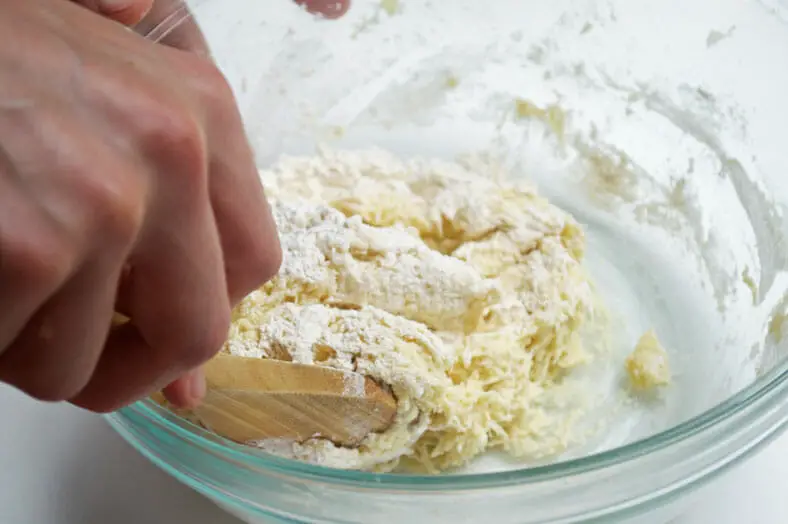

Your dough is ready to go when it’s so thick that it’s difficult to move a ladle through it. In fact, one fun trick you can try is to stick the ladle in the middle of the dough, let it go, and see how long it stays standing! This is the type of consistency that will hold up against the ravages of ferociously boiling water.
Now it’s time to cook the halusky. The traditional way starts by laying your dough flat onto a flat surface like a tray or a cutting board. From there, you can use a special halusky scraper to drop gnocchi-sized pieces into the boiling water. Failing that, a regular knife will do just fine.
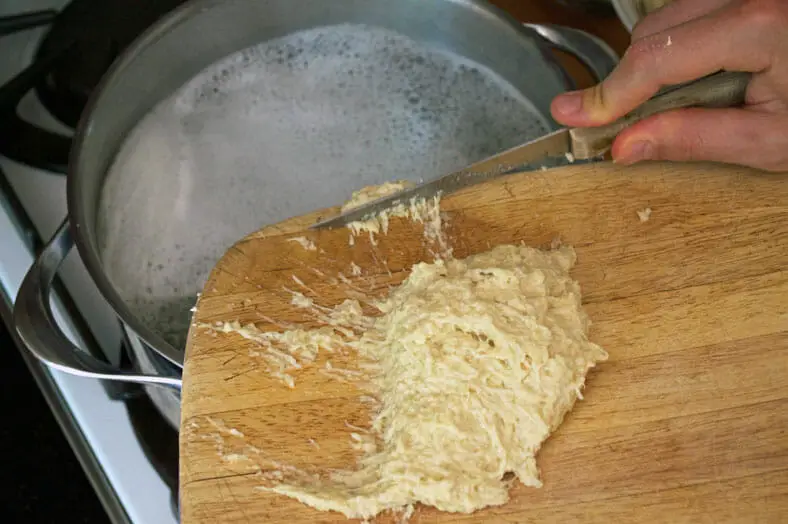
Once they’re in the boiling water, these little dumplings don’t take long at all to cook. After just 2-3 minutes, you’ll notice the dumplings starting to rise and float to the top, which is your cue to take them out. There is another special halusky tool to remove them, but really a slotted spoon or ladle will do the trick just fine here.
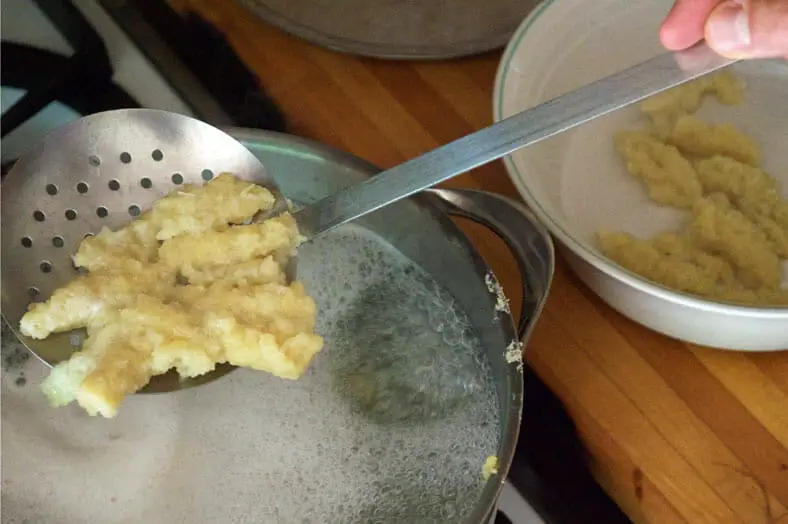
Repeat this until all your dough is gone, and you’ve just made halusky!
Now, potato and flour dumplings by themselves wouldn’t taste like much, so your final step is to fold them into your bryndza cheese. If you couldn’t find true bryndza like us, any type of sheep’s cheese (like a good ricotta in our case) will do the trick. And if you feel so inclined, cooked bacon also adds a nice element of flavor to the dish too.
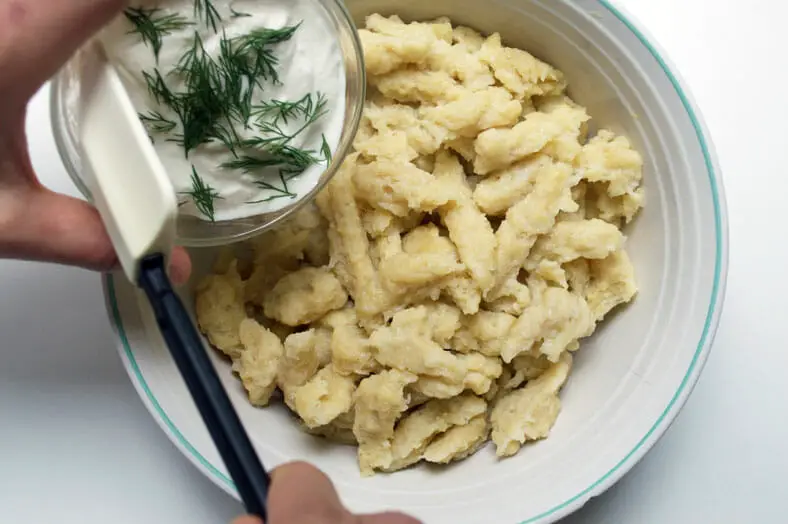
OUR TAKE ON THE RECIPE
There’s a lot of great documentation online about halusky, its ingredients and even the special tools used for it! For a fairly straightforward recipe like this one, then, we had ourselves the pick of the litter. Ultimately, though we chose this recipe as our reference because of its simplicity.
In the absence of several key ingredients (and tools!), we did have to make some adjustments to our recipe. For starters, we had a lot of trouble finding bryndza near us, so we swapped it out for ricotta. We also couldn’t find any mangalitsa bacon – bacon made from a special type of domesticated Hungarian pig – so we used regular bacon instead.
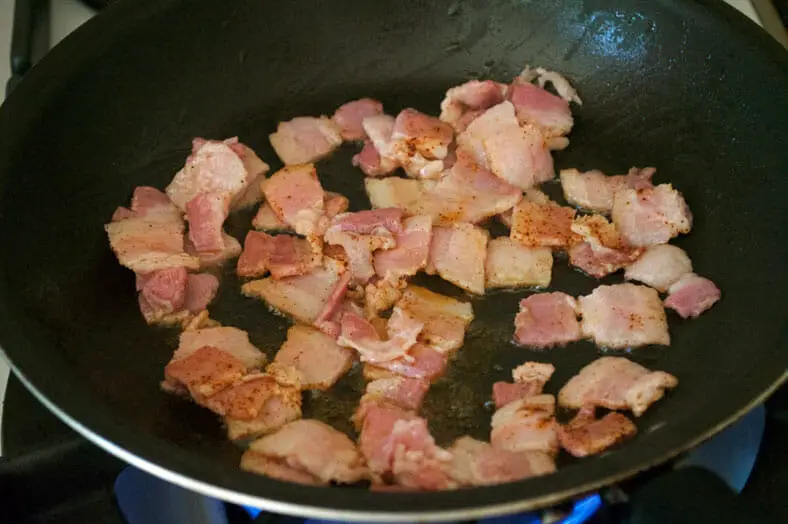
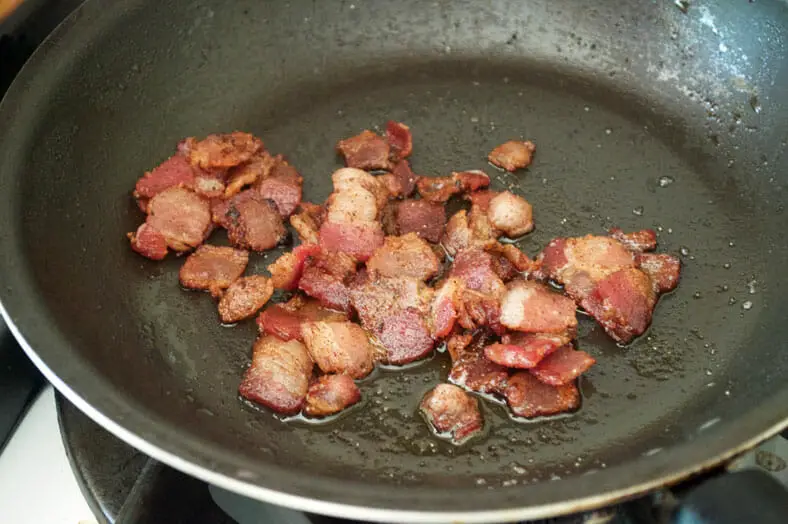
As for the halusky batter itself, we put together a mix of chickpea flour with all purpose flour to create a slightly healthier (only slightly) binder for the potatoes. The chickpea flour was more a test on a whim, but it turned out to give a subtle added flavor to the dumplings overall.
Alas, we also missed out on having the special tools for halusky, so we had to instead stick with a knife and a regular open slotted spoon to do the trick.
Otherwise, it’s a very simple and easy recipe to make, and it’s one that can be made in no time for a fun, wholesome mealtime. Be sure to serve these yummy dumplings with the best pairings for them!
How would you prepare your halusky? Comment below!



Halusky: Slovak Potato Dumplings
- Total Time: 20 minutes
Ingredients
- 3 medium potatoes, peeled
- 1 cup chickpea flour
- 1 cup unbleached all purpose flour (optional)
- 1 teaspoon salt
- 1/2 cup bryndza or a similar semi-soft sheep cheese like ricotta
- 1/4 cup small bacon bits (optional as garnish)
- 1 handful fresh dill, chopped (optional as garnish)
- 1 handful fresh chives, chopped (optional as garnish)
Instructions
Stage 1 – Create Halusky Dough
- Start by grating your peeled potatoes into a large bowl. The smaller the size of the grate, the better. Continue until you’ve grated all of your potatoes
- To remove excess moisture from your potatoes (which might cause your halusky to fall apart), strain your shredded potatoes through a colander. Ideally, keep your colander over a smaller bowl where you can collect the liquid. The liquid (and the starch that starts to separate to the bottom) can serve as a beautiful emulsifier either for these dumplings or for anything else
- After straining, return your grated potatoes to the large bowl
- Next, start to ladle your flour mix in with the potatoes. You want to add it in bit by bit, making sure that each bit of flour has integrated well into the grated potatoes before adding the next batch of flour. Repeat until all your flour has been added and you’ve created a super thick dough that, if you stick the ladle straight in, will keep the ladle sticking straight up
Stage 2 – Boil and Cook Halusky
- Take a large stockpot full of water (with your teaspoon of salt) and bring to a boil over high heat. While the water is coming to a boil, transfer your dough to either a cutting board, a plate, or another flat surface
- Once the water has come to a running boil, use either a spoon or knife to scrape small pieces of your haluschky dough into the water. Here you can make your dumplings as small or as large as you’d like (we preferred small personally)
- Let your dumplings boil in the water. They will start by sinking to the bottom, but once they’ve cooked (around the 2-3 minute mark), they will start to rise and float to the top
- Take a slotted spoon or ladle to fish out the haluschky that are cooked and floating to the top. Set either into a bowl or onto a plate, and set aside
- Repeat and continue until you’ve created dumplings out of all your dough
Stage 3 – Add Finishing Touches to Halusky
- If making bacon, take the bacon over medium-high heat in a sauté pan and cook for 2-3 minutes until brown and crispy. Once cooked, strain bacon bits of excess oil and set aside for a brief moment
- Place your halusky into a mixing bowl and add your ricotta. Mix well together until all of your dumplings are nicely coated with cheese
To serve, garnish with your freshly cooked bacon, fresh chives and fresh dill. Enjoy!
- Prep Time: 10 min
- Cook Time: 10 min
